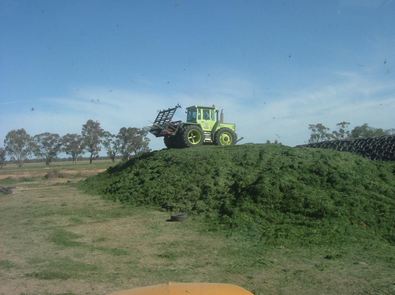



Forage Focus: Cereal Rye a Cover Crop with Feed Value?
Dairy and beef producers should look into rye as a grazing or forage crop because of good performance across the board, according to an Ohio State Extension Educator.
In recent years, rye (Secale cereale L.), also known as cereal rye or winter rye, has been planted by producers as an entry level or "user friendly" cover crop, says Eric Richer, OSU Extension Educator, Fulton County.
As a cover crop, it is a great nutrient recycler, soil builder, topsoil loosener, and erosion preventer, writes Mr Richer.
For dairy and beef producers, rye can also be considered for additional grazing or forage value. Based on surveys from several Northwest Ohio producers who have used rye as a spring feed source, it can provide additional feed tonnage on idle acres in a corn-soybeans rotation and with minimal effort or expense.

According to the Ohio Agronomy Guide, rye is most winter hardy and earliest maturing cereal grain grown in Ohio.
While spring rye-lage will not have the same feed value as corn silage, producers can evaluate its cost per pound of gain to see if it may fit in their total mixed ration (TMR) feeding systems.
Based on feed analyses from five producers, the ranges for some key feed quality indicators on a dry basis were: yield of 2-3 T/ac, harvested at dry matters of 21-32 per cent (avg. 27 per cent ), crude protein 8-13 per cent (avg. 12 per cent ), Total Digestible Nutrients (TDN) 53-63 per cent (avg. 61 per cent ), Net Energy Gain of .24-.38 mcal/lb, Net Energy Lactation of .54-.67 mcal/lb, and Relative Feed Value (RFV) of 71-121 (avg. 101).
These analyses were from rye harvested the start of boot all the way to full head, thus ranges and quality vary.
How do you produce rye for rye-lage? Since many producers no-till soybeans and the planting window for soybeans is a little later, consider planting rye after silage corn or early harvested corn that is going to no-till soybeans in the spring. This timeframe fits well into many cover crop programs and one of the advantages of rye is that it will germinate up to November 1st on normal years.
As with all of our crops, starting with a clean seedbed is very important. Fields with a history of winter annuals (ie. marestail) need to have a cleanly tilled seedbed or follow Dr. Mark Loux's "Burndown Suggestions for No-tillage Wheat" (C.O.R.N. 2013-30, Sept. 10-17, 2013). Rye planted for forage production should be drilled at a rate of 85-115 lbs/acre-more than typical cover cropping rates-- and ideally by October 20th.
Fertility for high production rye is similar to wheat and starter fertilizer should be applied according to soil test results and the Tri-State Fertility Guide (see "Important Wheat Management Guidelines", Lentz et al. C.O.R.N. 2013-30, Sept. 10-17, 2013).
Producers should be sure to account for full crop and stover removal and consider fertilizing for the subsequent soybean crop. In livestock situations, manure may be incorporated in the fall in place of starter fertilizer. Of course if you are just trying to scavenge nutrients, level of starter fertilizer use is up to the producer. In the spring, up to 50 lbs/acre of nitrogen can be top-dressed to increase production before termination.
Mowing of rye at boot stage (mid-May) is most ideal for tonnage, feed quality and palatability. Harvesting at this time reduces some of the concerns with rye limiting soil moisture and nitrogen to subsequent crops.
Mowing can be done with a disk-bine or haybine, but drying can be a challenge. A chopper with a pick up head can be used to harvest the rye-lage at 25-30 per cent dry matter. Cut length should be adjusted to .75-1" for best results. Rye-lage should be packed and covered similar to corn silage to maintain its quality. After rye harvest, soybeans can still be planted and normal yields realized.


